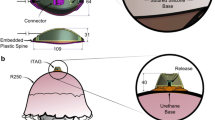Abstract
An experimental technique for measuring the feeding behavior of copepods on small time scales is important because grazer/micro-patch interactions in the ocean are probably short (minutes to hours). By placing copepods with empty guts into a known food concentration and monitoring the rate of increase in gut contents until defecation begins, usually 20 to 100 min, the volume of water swept clear of particles per min can be calculated. This process is easily quantified by using phytoplankton as food and measuring the gut contents by fluorometry. The utility of this technique is demonstrated in the laboratory and at sea.
Similar content being viewed by others
Literature cited
Conover, R. J. and V. Francis: The use of radioactive isotopes to measure the transfer of materials in aquatic food chains. Mar. Biol. 18, 272–283 (1973)
Corner, E. D. S., R. N. Head, and C. C. Kilvington: On the nutrition and metabolism of zooplankton. VIII. The grazing of Biddulphia cells by Calanus helgolandicus. J. mar. biol. Ass. U.K. 52, 847–861 (1972)
Dagg, M. J. and D. W. Grill: Natural feeding rates of Centropages typicus females in the New York Bight. Limnol. Oceanogr. 25, 597–609 (1980)
Deason, E. E.: Grazing of Acartia hudsonica (A. clausi) on Skeletonema costatum in Narragansett Bay (USA): influence of food concentration and temperature. Mar. Biol. 60, 101–113 (1980)
Derenbach, J. B., H. Astheimer, H. P. Hansen and H. Leach: Vertical microscale distribution of phytoplankton in relation to the thermocline. Mar. Ecol. Prog. Ser. 1, 187–193 (1979)
Frost, B. W.: Effects of size and concentration of food particles on the feeding behavior of the marine planktonic copepod Calanus pacificus. Limnol. Oceanogr. 17, 805–815 (1972)
Frost, B. W.: A threshold feeding behavior in Calanus pacificus. Limnol. Oceanogr. 20, 263–266 (1975)
Frost, B. W.: Feeding behavior of Calanus pacificus in mixtures of food particles. Limnol. Oceanogr. 22, 472–491 (1977)
Haney, J. F. and D. J. Hall: Diel vertical migration and filter-feeding activities of Daphnia. Arch. Hydrobiol. 75, 413–441 (1975)
Harris, R. P.: Comparison of the feeding behavior of Calanus and Pseudocalanus in two experimentally manipulated enclosed ecosystems. J. mar. biol. Ass. U.K. 62, 71–91 (1982)
Lasker, R.: Field criteria for survival of anchovy larvae: the relation between inshore chlorophyll maximum layers and successful first feeding. Fish. Bull. U.S. 73, 453–462 (1975)
Lasker, R.: The relation between oceanographic conditions and larval anchovy food in the California current: identification of factors contributing to recruitment failure. Rapp. P.-v. Reun Cons. int. Explor. Mer. 173, 212–230 (1978)
Longhurst, A. R., and A. W. Herman: Do oceanic zooplankton aggregate at, or near, the deep chlorophyll maximum? J. mar. Res. 39, 353–356 (1981)
Mackas, D., and R. Bohrer: Fluorescence analysis of zooplankton gut contents and an investigation of diel feeding patterns. J. exp. mar. Biol. Ecol. 25, 77–85 (1976)
Mullin, M. M., and E. R. Brooks: Some consequences of distributional heterogeneity of phytoplankton and zooplankton. Limnol. Oceanogr. 21, 784–796 (1976)
Nival, P. and S. Nival: Particle retention efficiencies of an herbivorous copepod, Acartia clausi (adult and copepodite stages): effects on grazing. Limnol. Oceanogr. 21, 24–38 (1976)
Ortner, P. B., P. H. Wiebe and J. L. Cox: Reply to “Do oceanographic zooplankton aggregate at, or near, the deep chlorophyll maximum? J. mar. Res. 39, 357–359 (1981)
Poulet, S. A. and P. Marsot. Chemosensory grazing by marine calanoid copepods (Arthropoda: Crustacea). Science, N.Y. 200, 1403–1405 (1978)
Roman, M. R. and P. A. Rublee: A method to determine in-situ zooplankton grazing rates on natural particle assemblages. Mar. Biol. 65: 303–309 (1981)
Runge, J. A.: Effects of hunger and season on the feeding behavior of Calanus pacificus. Limnol. Oceanogr. 25, 134–145 (1980)
Schindler, D. W.: Feeding, assimilation and respiration rates of Daphnia magna under various environmental conditions and their relation to production estimates. J. Anim. Ecol. 37, 369–385 (1968)
Shuman, F. R. and C. Lorenzen: Quantitative degradation of chlorophyll by a marine herbivore. Limnol. Oceanogr. 20, 580–586 (1975)
Strickland, J. D. H. and T. R. Parsons: A practical handbook of seawater analysis. Bull Fish. Res. Bd. Can. 167, 1–310 (1968)
Wilson, D. S.: Food size selection among copepods. Ecology 54, 909–914 (1973)
Author information
Authors and Affiliations
Additional information
Communicated by J. M. Lawrence, Tampa
Rights and permissions
About this article
Cite this article
Dagg, M.J. A method for the determination of copepod feeding rates during short time intervals. Mar. Biol. 75, 63–67 (1983). https://doi.org/10.1007/BF00392631
Accepted:
Issue Date:
DOI: https://doi.org/10.1007/BF00392631




